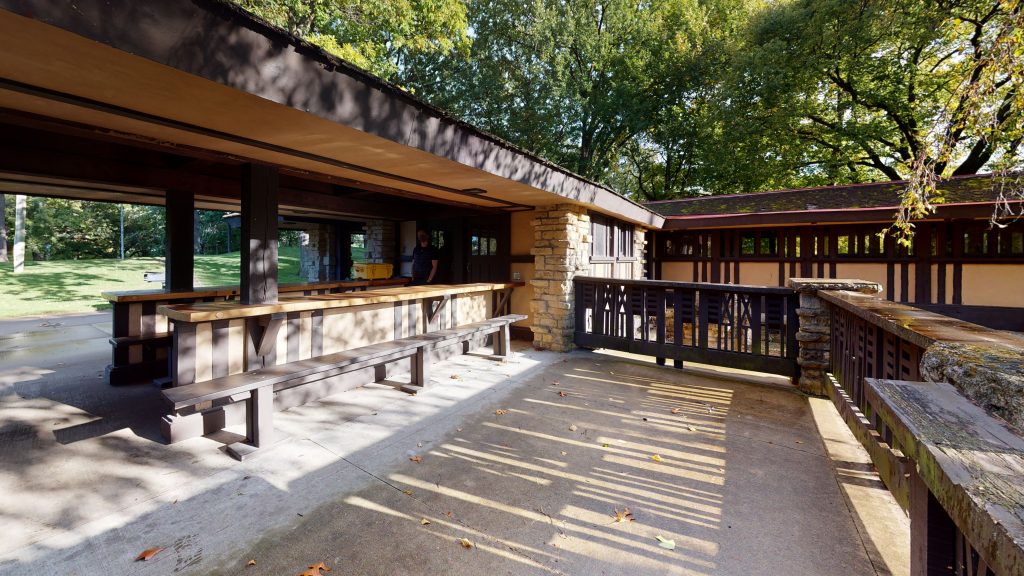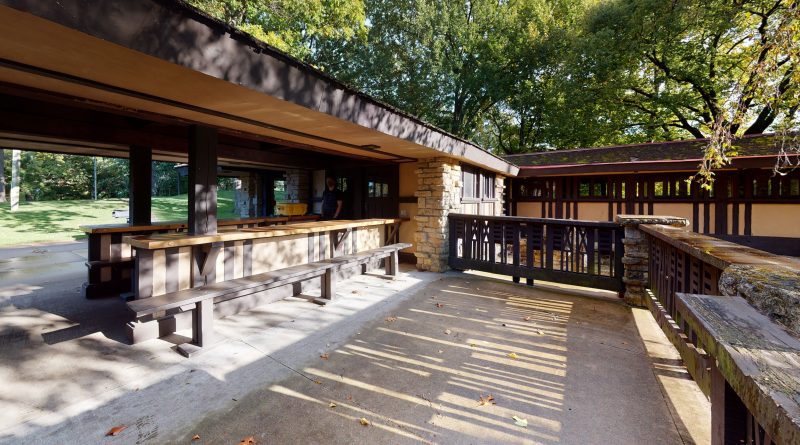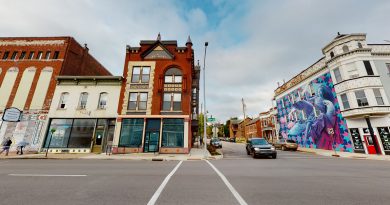Dubuque’s Eagle Point Park: Alfred Caldwell’s Unsung Masterpiece
Following imaging of Steeple Square in Dubuque, I headed out to Eagle Point Park, just a few minutes north of downtown. The route reminded me The park spans a respectable 164 acres on the bluffs above the Mississippi River and Lock and Dam No. 11. In one of the best illustrations of the Iowegian social contract I’ve ever seen, I was charged an entrance fee of a whopping $1.00, and the attendant told me coolly to “make sure you keep your receipt.” According to Duane Hagerty, who led me through the Steeple Square space, the $1.00 fee was, as best as he could recall, implemented in the 70’s (when it was a significant sum of money), to deter teenagers from scooping the loop, as it were, of the park drive.
Yet the city had, oddly enough, never hiked the rate. Some things change– like the newfound ubiquity of the wind turbine, definitive of Iowa’s popular aesthetic- while others, like the park fees or the prevalence of monumental dams on the Upper Mississippi, do not.
The Chicago Parkitects: Burnham, Jensen, and… Caldwell
A river child, having grown up in St. Louis and spent a substantial amount of time in Dubuque, Alfred Caldwell is perhaps better known for his Chicago works, as the architect of the Lily Pool in Lincoln Park (1936-38) as well as Promontory Point in Burnham Park. Yet of the Chicago starchitects– or parkitects, perhaps- Alfred Caldwell may be the least-known, having come a bit later than The Big’Uns. I admit that I wasn’t terribly familiar with the man prior to this visit. I was familiar with Jens Jensen (1860-1951, one of Caldwell’s mentors) and, of course, Daniel Burnham (1846-1912).
Burnham and Jensen were famous for pioneering what were then pretty groundbreaking greenway structures connecting disparate neighborhoods through parks and parkways. Both had complementary– and at times competing- visions for the future of the city’s urban design. Jensen’s design proposals embraced the stalwart austerity of the rectilinear cadastral survey that gridded Chicago, the rest of the Midwest, and would eventually cover more than two thirds of the United States.
Jensen, coming later than Burnham, focused substantially on the parkways farther from the lakefront. Burnham’s only-partially-realized master plan (1909), in contrast, envisioned curvilinear green spaces overlaid onto the city’s stolid grid– among many other ideas. Burnham was heavily focused on the lakefront, where a majority of Chicago park space remains concentrated to this day. This is a subject of critique from city planners and socially-minded Chicagoans alike. One also becomes critically aware of this after having tried to ride a bike down the lakefront trails on a beautiful summer day and avoid That Bro Training For A Marathon. (Or a family whose five kids are running to and fro. Or tourists who do not understand how to ride bikes. Or, as I once saw, a family of raccoons).
Pushing Back Against Industrialization
Jensen’s parks plan came several years later, and proposed an expansion of the western parks system, which ended up falling flat after he butted heads with Chicago’s entrenched political machine. Both men would leave indelible marks on the city, however, and become revered as pioneers of urban design, especially in the context of nature’s metropolis. Indeed, much of the expansion of parks– in Chicago proper and open space conservation in the adjacent Indiana Dunes- were a direct pushback against rapid urbanization and the dirty effects of industrialization in both the city and the surrounding hinterlands.
Discourse about the City Beautiful movement (ca. 1890s-1910s) seems more focused with the movement’s preoccupation with the monumental grandeur of Beaux-Arts architecture. While this was important in directing the development of modern city planning, it’s perhaps most valuable to understand it in the context of parallel, competing, and intersecting movements that pushed back on the industrialization of cities, which, then relatively unchecked, brought the “most filthy and deadening and brutalizing work […] a cause of anemia, nervousness, ugliness, and ill-temper: of prostitution, suicide, and insanity” (quoting Upton Sinclair’s 1909 The Jungle here). Ebenezer Howard’s City Beautiful movement came around this time (1898), as did John Muir’s Sierra Club (1892), which endures to this day. Jens Jensen was a founding member of The Prairie Club (1909), whose members rallied to conserve dunelands just a short trip from Chicago.
Green Space vs. Brown Space
Today, we think of Chicago as a fairly green city. Such was not the case when Upton Sinclair characterized the city’s notorious meatpacking industry. The greening of the city was not a product of some innately American affinity for trees. It was a product on the pushback against the unchecked commodification of everything contained within urban space-time– against ubiquitous, unregulated extraction for the sake of profit. Jensen’s and others staunch support for conservation– indeed, this essentially ended up getting Jensen fired from his job with the park department- was an attempt to create a both literal and figurative track for green space running alongside that of industrialization. This peculiar duality continues in the dunes to this day, with the National Park sandwiched between US Steel’s Gary Works and US Steel’s Midwest plant. (Gone are the once-great dunes that were hundreds of feet high– but now we have Ball jars instead!).
This brings us to Caldwell.

The Last Architect of the Prairie School
Caldwell came a lot later. He studied with Jensen in the 1920’s. Both men did commissions in Detroit, which was, in those years, hot stuff; Jensen collaborated with Albert Kahn to build the Edsel and Eleanor Ford estate (1928), and Caldwell with Mies van der Rohe on Lafayette Park (1956). One author called Caldwell the last architect of the Prairie school. (Frank Lloyd Wright had by his later years moved to building chonky buildings like the Price Tower, 1952-56, which looks more like a part on a circuitboard than like a plains-referential structure, or the peculiar Gammage Auditorium, 1959-64 and completed after his death).
Caldwell’s works both contrast and complement Prairie and Prairie-adjacent colleagues, and his style is defined by a prominent use of stratified stonework, linear expanses complemented by austere, slim, repetitive vertical forms. The reference to the prairie here is in the repetitive simplicity of prairie grasses, which formerly covered much of the middle states, and the gentle undulation of the landscapes. While Louis Sullivan’s Jewel Box banks essentially said, “these lands are flat, let’s just build a big old box!” we see a lot more inspiration from Wright’s affinity for jutting, yet topographically gentle, perpendicular forms in Caldwell’s works here.
The WPA Spirit: Communal Enjoyment of Nature
The WPA structures in Eagle Point Park specifically feature locally quarried sandstone. In line with much of the general WPA vibe of big outdoorspersonly camping energy, the park’s structures also feature a lot of large, common fireplaces built into rough-hewn stone. Want to have a fire inside the lodge? Go for it. Want to have a fire outside the lodge? You can do that, too! Not sure which angle of the building you want to be seated on? How about lighting a fire in one of the corner fireplaces (check out the model). I’ve seen a lot of things, but I am not sure I’ve ever seen a corner fireplace. Truly wild.
Beyond the building arts, Caldwell was prolific, less as solely an architect than as a polymath dabbling in many fields. He also, according to one account, suffered for art:
When he grew frustrated with the newly formed Park District’s lack of support, he cashed in his life insurance policy and spent $300 on wildflowers to create the natural carpet that his superiors had rejected. He drove to Wisconsin with a work crew, hauled the plants back, and helped set them himself, in the niches between stones.
Such is, one supposes, the wont of a visionary whose dreams cannot be contained by, uh, restrictive municipal bureaucracy. (Something I know nothing about). The Chicago bureaucracy eventually fired Caldwell– twice, finally in 1940. He has a Wikipedia page. Most of the city’s bureaucrats do not. I found inspiration in this as I scanned the Eagle Point structures, well past my planned time of departure in order to get home in time to do another job the following morning, and thinking back on my own time working in an unmitigated disaster of a municipal bureaucracy.
Historic preservation
Dubuque-based Heritage Works‘ CEO Duane Hagerty, who sits on the board of Steeple Square, calls Eagle Point Park “the most significant historic architecture ensemble in Dubuque,” factoring in not only the buildings but also the adjacent lily pond, council rings, and various ledges and patios, which all feature distinct architectural elements from their stone design.
Hagerty is encouraged by the presence of Caldwell groupies in Chicago, who, he says, “will be more than willing to lend their expertise to coming up with preservation plans” for the Caldwell structures. Chicago-based John Vinci (Vinci Hamp) was a student of Caldwell’s, Hagerty tells us, when Caldwell was teaching at IIT. He also mentions Julia Bachrach, the former historian for the Chicago Parks District who gave a talk in Dubuque about Caldwell’s work here. With the centennial of the park coming up in 2036, Hagerty says that the city has done an “admirable job” but says that the site could use some substantial restoration work.
Just as the WPA was a monumental project within the far more monumental New Deal, we may need a similarly gargantuan stimulus package to dig ourselves out of the current economic mess we’re in. I think we might all like to see Eagle Point included in this!
Epilogue
The enduring legacy of the Eagle Point Park buildings were a welcome invitation to learn about an unsung, or at least, certainly, under-sung hero– and to think about how we can honor not only his legacy, but the legacy of the physical place and ecological context in which these buildings are situated. The legacy is also one that pays homage to an era when people enjoyed hanging out with one another. These days, hanging out at that frat party known as a state park campground, camping feels like something more dependent upon your F250 Super Duty and your trailer and its accompanying, color-changing LED lights and sound system, rather than, say, sitting around a communal fireplace in an old lodge with your best friends. As COVID separates us physically and political polarization drives wedges into the very heart of American democracy, this is a point well-taken– and one we should consider when thinking about how to preserve and occupy these spaces in the future.

Learn more about Eagle Point Park in Dubuque, or about Imagine Dubuque, the city’s comprehensive plan. Matterport imaging services were provided pro bono to the City of Dubuque. Although Duane Hagerty of Heritage Works did buy me a pizza, which I confess to having eaten basically all of.


